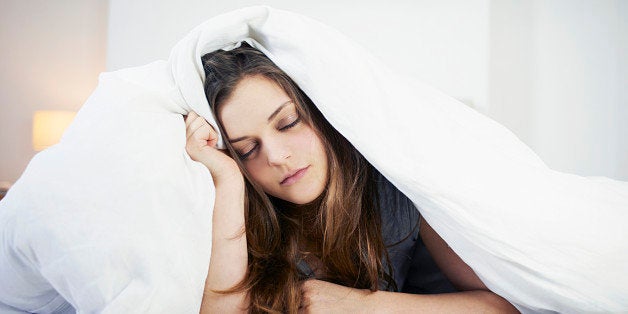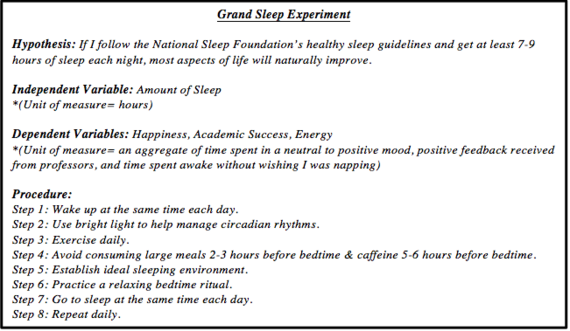
In an effort to change how Georgetown University students and professors think about sleep, I recently wrote an article describing our university's poor sleep culture. I made the argument that getting the proper amount of sleep would help students achieve their goals and in Georgetown President John J. DeGioia's words, "become their very best selves."
In the weeks since, my mother and my roommate have been quick to point out that, on occasion, I too find it difficult to heed my own advice. So in an effort to practice what I preach, I set out on a grand sleep experiment. The design was as follows:
It was as simple as that. For one week, I would follow the National Sleep Foundation's healthy sleep guidelines to a T. And if things went as planned, I'd be a well-rested sleep guru in seven short days.
But...things didn't go as planned...and I've finally been forced to accept that they generally never do for 20-year-old college students.
Step 1: Wake up at the same time each day.
No problem. DC Water employees facilitated this step, conducting a major construction project on my street the same week. Each morning when the clock struck eight, my neon-vested friends made sure I was awake with a jolting chorus of jackhammers. By Friday, the construction got so close to my house that the vibrations shaking the ground actually woke me up. Definitely no snoozing that day.
Step 2: Use bright light to help manage circadian rhythms.
Little to no problem with this step either. The bedroom of my university townhouse might be the brightest location imaginable that is not itself the sun. The quest for darkness to help manage circadian rhythms was far more formidable.
Step 3: Exercise daily.
Here we begin to run into problems. On four of the seven days of my experiment, I did at least sixty minutes of cardio. On two days, I had too many classes and extracurricular commitments to work out. And on the remaining day, my creative writing professor decided to distribute a poem I wrote about a boy to my entire class, all but forcing me to avoid public areas (including the gym) until the storm of embarrassment had passed.
However, some may have considered that last incident a cardio activity, as my heart rate did indeed remain elevated for an extended period of time.
Step 4: Avoid consuming large meals 2-3 hours before bedtime & caffeine 5-6 hours before bedtime.
Another problem area. Large meals? Not too bad. I generally prefer to eat miniscule amounts of food at a continuous rate throughout the day anyways. As for caffeine...as the venerable Scooby Doo might say, "Ruh, roh." To begin with, you'd never imagine just how many beverages and foods contain caffeine. Even Earl Grey tea! I've watched my mother drink a cup of said tea before bed every night of my life, and it was only staring at the ceiling at 2:00 a.m. that I understood not all Earl Grey tea is of the decaf variation.
Step 5: Establish ideal sleeping environment.
This was probably the easiest step to achieve. I bought a new pillow and outfitted my bed in fresh clean sheets. I turned off the lights, turned down the air, and spritzed some febreeze. Once a ratty college dorm, my room was suddenly a slumber palace.
Step 6: Practice a relaxing bedtime ritual.
A thought-provoking recommendation. The National Sleep Foundation suggests following a guided meditation, reading, or deep breathing to calm the central nervous system and ultimately signal to the body that it is time for sleep. I tried them all. The most effective guided meditation I found was the podcast "Sleep with Me." Unfortunately, just as I was about to doze off, my roommate knocked on the door, fearing the sound of the podcast was actually a mouse.
Step 7: Go to bed at the same time each day.
I really did try to follow this one, but as any college student could attest, life came up and none of my days were the same. On Monday, I had to stay up to hear the results of the Iowa Caucus. On Tuesday, I had to finish my theology reading. On Wednesday, my best friend had an identity crisis. And so the list went on. What I did commit to was at least making sure I was physically in my bed by 11:30 p.m. each night.
Results:
Aside from construction waking me up at 8:00 a.m. on the dot every day, almost none of my experimental procedure went exactly according to plan. What I can report is that even the small steps I took made an enormous difference in the quality of my sleeping and waking hours. During the week of my experiment, I was more alert in class. I felt much less tired than I usually do during the day. I actually - gasp - looked forward to going to the gym. My time and my emotions were more easily managed and my days seemed brighter.
As college students and as humans, we often look to a far-off "better" future as the time when we'll get good sleep. In the course of my Grand Sleep Experiment, I learned that we need not wait for such an elusive time. Even a few small changes to your sleep routine can result in incredible health gains. Why not start now?
This post is part of our series on sleep culture on college campuses. To join the conversation and share your own story, please email our Director of College Outreach Abby Williams directly at abigail.williams@huffingtonpost.com. And you can find out here if the #SleepRevolution College Tour will be visiting your campus, and learn how you can get involved. If your college is not one of the colleges already on our tour and you want it to be, please get in touch with Abby.

